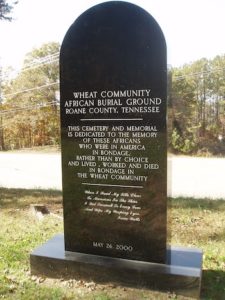
Cemetery Monument
*The Wheat Community African Burial Ground is celebrated on this date in the 1850s. Wheat was a farming community in Roane County, Tennessee.
The area is now in the city of Oak Ridge. Discovered in the early 2000s, this 1850s slave cemetery is the final resting place of more than 90 unmarked graves. The earliest settlers moved into the area in the late 18th century. However, it was not until 1846 that the area was established as the community of Bald Hill. The name was changed to Wheat in 1880 when a post office was opened, and the community took the name of its first postmaster, Frank Wheat.
Early farming residents included John Henry and Elizabeth Inman Welcker. They owned Laurel Banks plantation on the Clinch River from the early 19th century until about 1840. Records from that time show that the Welckers were active in the purchase and sale of slaves. George Hamilton Gallaher purchased the property in the 1840s, and it is now referred to as the Gallaher-Stone Plantation.
The Wheat Community African Burial Ground and Gallaher-Welcker Cemetery still survived. The slaves are initially believed to be part of the Gallaher-Stone Plantation in what was formerly known as the Wheat Community before WWII's Manhattan Project. That venture required the land now known as Oak Ridge as part of the effort to build the A-Bomb and end the war.
The African Burial Ground was long forgotten, but it was rediscovered in 2000 by Will Minter. The site was subsequently cleaned up and marked by U.S. Department of Energy personnel and volunteers. At least some of those buried in the African Burial Ground are believed to have been part of the Gallaher-Stone Plantation; a monument to those held in slavery on the cemetery grounds was placed on this date.